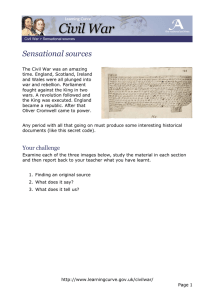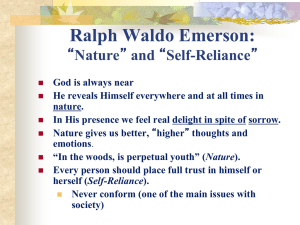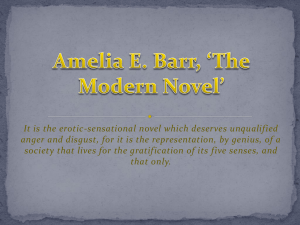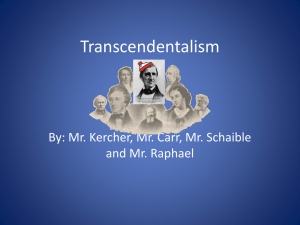Religious Sensations
advertisement
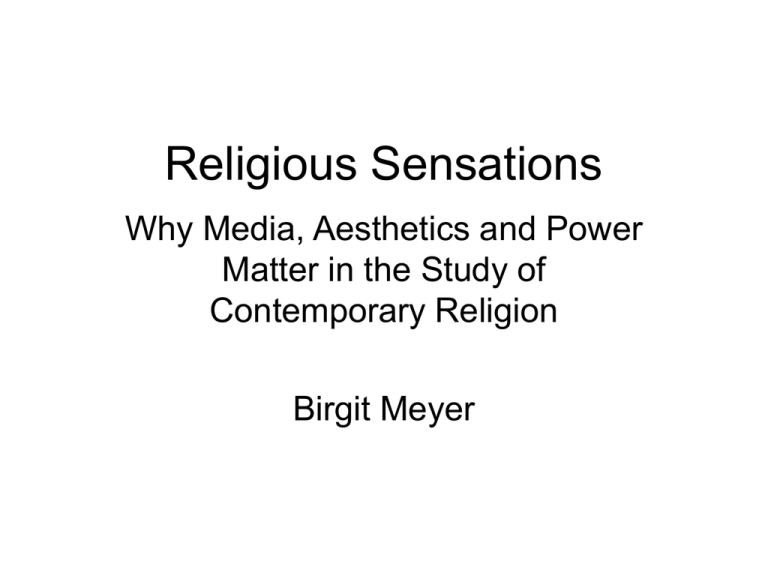
Religious Sensations Why Media, Aesthetics and Power Matter in the Study of Contemporary Religion Birgit Meyer Parool 19/9/2006 NRC 28/9/2006 NRC 28/9/2006 Internationale Samenwerking 3/2005 NRC 12/8/2006 NRC 23/5/2006 Religious sensations William James on religion: ‘the feelings, acts, and experiences of individual men in their solitude, so far as they apprehend themselves to stand in relation to whatever they may consider the divine.’ William James, Varieties of Religious Experience [1902] ‘Sensational forms, in my understanding, are relatively fixed, authorized modes of invoking, and organizing access to the transcendental, thereby creating and sustaining links between religious practitioners in the context of particular religious organizations. Sensational forms are transmitted and shared, they involve religious practitioners in particular practices of worship and play a central role in forming religious subjects.’ Mama Lola (K. McCarthy Brown)) Mensa Otabil, by courtesy of Marleen de Witte Bus stop, Accra, 2003 Stills from televised church service, ICGC, by courtesy of Marleen de Witte Christ for All Nations, The Ministry of Evangelist Reinhard Bonnke Modern media and mediation ‘The transcendental is not a self-revealing entity, but, on the contrary, always “affected” or “formed” by mediation processes, in that media and practices of mediation invoke the transcendental via particular sensational forms. These sensational forms mediate the transcendental and, in our time increasingly so, depend on modern media as print, and electronic audio-visual devices.’ From D. Morgan & S. Promey, Exhibiting the Visual Culture of American Religions, 2000; Material Religion 1 (3), 2005 From Ch. Pinney: ‘Photos of the Gods’, 2004 Portraits of King Chulalongkorn, by courtesy of Irene Stengs Gilbert Forson Art Workshop, Ghana 2003 Still from Stolen Bible: On the surface of the water in a calabash, the ‘fetishpriest’ sees the Pentecostal pastor in action. Poster advertizing the video-movie ‘Deliverance from the Powers of Darkness’ From A.F. Roberts and M. Nooter Roberts, A Saint in the City, 2003. From I. Hofmeyr, The Portable Bunyan, 2004 Aesthetics and aisthesis ‘Religious organizations can be characterized as having distinct sensory regimes. Religious subjects are created (ideally, that is) by a structured process- a religious didactics – in which the senses are called upon and tuned in a way that yields a habitus. This process not only entails a strong emphasis on specific, privileged sensory and extra-sensory perceptions, but also the tuning down or anaesthization of other senses or sensory perceptions.’ ‘Sensational forms, though produced and in a sense “made up”, appear as offering immediate access to the transcendental exactly because they are – literally – incorporated and embodied by their beholders. These forms invoke and perpetuate shared experiences, emotions and affects that are anchored in a taken-for-granted sense of self and community, indeed a common sense that is rarely subject to questioning exactly because it is grounded in shared perceptions and sensations. Common sense is what gets under the skin, enveloping us in the assurance “this is what really is”.’ From J. Spaans, De democratisering van het religieus accessoire,2003. From K. Nomachi, Pelgrimage, 2005 Predikant Wiersma en echtgenote, collectie Museum Catharijneconvent Madonna: Confession Tour, 2006 NRC 7/2/2006 Power Conclusion ‘My plea to pay attention to 1) the modern media that play a role in objectifying the transcendental into material, sensational forms, 2) the particular religious aesthetics that modulate the body and tune the senses in a particular way, and 3) power as bringing into being subjects and communities with distinctive religious identities and styles, stresses the importance to approach religion from a material angle.’ Afsluitend Thank you! Hartelijk dank! Herzlichen Dank!

